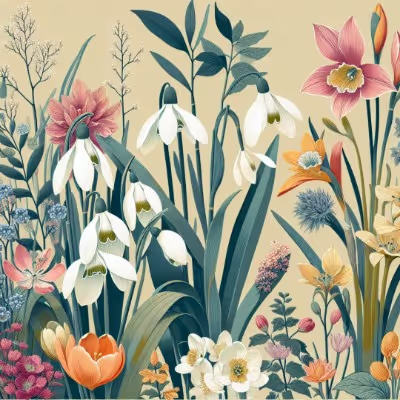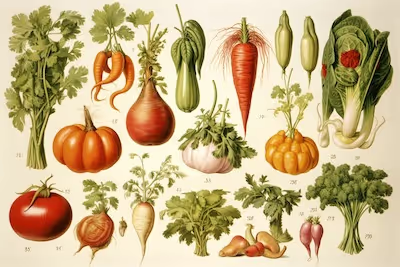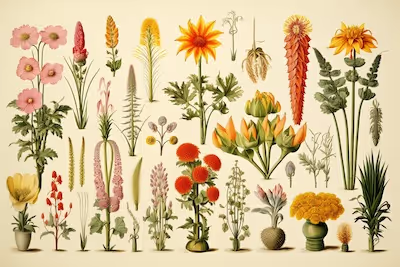What to Plant in August for a Healthy Late-Summer Garden

What to plant in August
Wondering what to plant in August? Sow fast-growing vegetables like spinach and radishes for crisp harvests into fall, drop in vibrant perennials such as coneflowers to attract pollinators, and prep cool-weather greens like kale and Swiss chard to savor as summer fades. Here's your warm-weather roadmap to keep the garden thriving deliciously right through season's end.
Cheatsheet: August Planting for Strong Late Gardens
🌱 Cool-Season Edibles
- Leafy greens: Spinach, lettuce, arugula, kale
- Roots: Radish, beets, carrots, turnips
- Brassicas: Broccoli, kohlrabi, cabbage
- Herbs: Cilantro, dill, chives
🍠 Transplants for Quick Harvest
- Asian greens: Bok choy, tatsoi
- Swiss chard
- Collards
💪 Nutrition & Self-Sufficiency Boost
Late plantings fill plates with vitamin-rich greens and roots, supporting immunity and energy into autumn. A single 4x8' (1.2 x 2.4 m) bed can yield 20–25 meal servings in 30–45 days.
🌡️ Timing & Soil Tips
- Soil temp: 60–75°F (16–24°C) for best sprouting
- Sow seeds slightly deeper (hot soil dries fast)
- Water daily until germination (7–14 days)
- Use shade cloth if days exceed 85°F (29°C)
🌻 Flowers for Pollinators
- Sunflowers (dwarf varieties)
- Calendula
- Cosmos
- Attract bees, boost veggie yields by up to 30%
🛠️ Tools and Products You’ll Need
- High-quality seeds or healthy starts
- Hand trowel or dibber
- Watering can or hose with fine spray
- Mulch (straw, compost)
- Row covers or shade cloth
- Plant tags
⚡ Step-by-Step Planting
- Remove spent crops and weeds.
- Work in compost; moisten soil.
- Plant seeds or transplants at depth per packet.
- Water gently and label rows.
- Mulch to hold moisture.
- Check daily for germination and pests.
- Harvest young for best flavor and nutrition.
I plan August like a pit stop, quick crops in and tired ones out, with fall on the horizon and heat still snarling. Your frost date, soil temperature, and day length drive the playbook.
- Arugula and baby leaf lettuce: 21 to 35 days for cut-and-come-again salads, germinate best at 60 to 75 F 16 to 24 C.
- Radishes: 25 to 35 days, keep them evenly moist or they go woody.
- Bush beans like Provider or Strike: 50 to 55 days in warm soils at 70 to 86 F 21 to 30 C.
- Summer squash and cucumbers: 45 to 60 days, pick small and often to keep vines pumping.
- Beets and turnips including Hakurei: 35 to 60 days, sweetest with cool nights.
- Baby carrots like Napoli: 50 to 60 days, sow a bit deeper to find cooler soil.
- Asian greens mizuna, tatsoi, komatsuna: 25 to 45 days, tuck under insect netting early.
- Bok choy: 35 to 50 days, steady moisture prevents tip burn.
I slot sturdy starts as the sun eases and nights cool. The crowns bulk up fast.
- Broccoli Belstar, Arcadia: 60 to 75 days after transplant, side shoots later.
- Kale Winterbor, Lacinato: harvest baby leaves in 25 days, full bunches in 50 to 60.
- Cabbage Kaitlin, Farao: 65 to 85 days, add a collar to block cutworms.
- Kohlrabi: 45 to 60 days, crisp bulbs if grown fast.
- Collards: 60 to 80 days, will carry you deep into frost with sweeter leaves.
- Basil: direct sow or root cuttings, keep night temps above 55 F 13 C.
- Dill: 30 to 40 days to leaf, resow every two weeks.
- Cilantro Calypso or Santo: late August in heat, earlier in cool zones for slow bolting.
- Chives and parsley: slow starters, perfect under light shade cloth.
- Zinnias and cosmos: fast bloomers, deadhead hard for waves of flowers.
- Calendula: thrives as nights cool, petals are edible.
- Nasturtiums: peppery salad leaves, excellent aphid trap crop.
- Sunflowers dwarf series: cheery screens, 50 to 60 days to flower.
I plant covers as green tools because they fix, feed, and keep weeds from running the kitchen. Pick by heat, moisture, and the window you have before frost.
- Buckwheat: 30 to 45 days to bloom, smothers weeds and feeds bees fast.
- Cowpeas or sunn hemp: love heat above 70 F 21 C, add nitrogen and biomass.
- Sorghum sudangrass: bulks up in heat, mow before it lignifies.
- Oats with crimson clover: late August in cool zones for soft winter-killed mulch and spring nitrogen.
“Buckwheat can flower in as little as 30 days, drawing pollinators while suppressing weeds.” USDA NRCS Cover Crop Guide
Focus on speed and frost tolerance. Sow arugula, spinach substitutes like mizuna, radish, baby carrots, beets, and set transplants of kale and broccoli early in the month.
Second sowings of bush beans, cukes, and squash still make it, plus all cool greens. I transplant brassicas through mid month and seed peas for fall snaps where nights dip under 65 F 18 C.
Lean on heat lovers and cover crops until late month, then start greens hard. Beans, okra, cowpeas, Malabar spinach, and late zinnias now, then arugula and cilantro as nights cool.
Protect young greens from heat with shade cloth and bottom watering. Cowpeas, basil, sweet potato slips where still feasible, then shift to a fall greens push near month’s end.
Use your mild nights for leafy speed. I sow carrots, beets, lettuce, and brassicas all August with fleece ready for slugs and coastal winds.
Chill lettuce and spinach seed 48 hours in the fridge, then sow at dawn under 30 percent shade cloth. I pre-sprout peas and beets on a damp paper towel at 68 F 20 C for reliable stands.
“Lettuce germination plummets above about 85 F 29 C, so start cool or start indoors.” UC Davis and Penn State Extension seed germination guidance
Sow a touch deeper, water twice daily until emergence, and mulch thinly with sifted compost. Soil acts like a pizza stone in August, so I keep it cool for the first week.
Plan for roughly 1 inch 25 mm of water weekly, which is about 0.62 gallons per square foot or 10 liters per square meter. I water at sunrise, mulch 2 to 3 inches 5 to 7.5 cm, and keep airflow high.
- Flea beetles and harlequin bugs: cover brassicas with fine insect netting immediately.
- Cabbage loopers: scout undersides and use Bt while larvae are small.
- Powdery mildew on squash: remove spotted leaves, improve spacing, drip irrigate only.
Many state extensions point out fall gardens often yield cleaner crops thanks to cooling nights and reduced insect pressure. Texas A&M AgriLife Extension
- Lettuce: Muir, Jericho, Salanova types for heat tolerance and quick baby cuts.
- Arugula: Astro for mild speed, Apollo for bolt resistance.
- Beans: Provider, Jade, and Contender for dependable late sets.
- Carrots: Napoli, Mokum, and Bolero for sweet fall crunch.
- Beets: Early Wonder Tall Top and Detroit Dark Red for greens and roots.
- Daikon: Minowase for crisp slabs, excellent kimchi later.
- Kale: Winterbor for curls, Red Russian for tender baby leaves.
- Broccoli: Belstar for heat tolerance, Arcadia for generous side shoots.
- Squash: Slick Pik and Dunja for fast fruit and mildew resistance.
- Cilantro: Calypso and Santo for slower bolting.
I pack late planters with salad mixes, baby beets, and dwarf beans. Use at least 5 gallons 19 liters for beans or squash, and water like clockwork.
This four-week cadence keeps beds producing while heat fades. I time harvests to clear space for transplants.
- Week 1: Pull spent peas and onions, add 1 inch 25 mm compost, sow arugula, radish, and bush beans.
- Week 2: Transplant broccoli and kale under netting, seed beets between them for a living mulch.
- Week 3: Direct sow carrots and bok choy at dusk, lay 30 percent shade cloth for seven days.
- Week 4: Plant buckwheat in any open strip, mow at first bloom to drop a green mulch.
I topdress 0.5 inch 12 mm of screened compost, water it in, then side-dress heavy feeders with 0.25 cup 60 ml balanced organic fertilizer per plant. In very hot regions, soil solarization with clear plastic for 4 to 6 weeks can push topsoil to 110 to 125 F 43 to 52 C, which knocks back soil pests, per UC ANR.
- Shade cloth 30 percent: drops leaf temperature and reduces transplant shock.
- Insect netting 0.8 mm mesh: keeps flea beetles and moths off without chemicals.
- Floating row cover about 0.55 oz per sq yd 18 g per m2: warms nights by a few degrees and blunts wind.
- Drip or soaker hoses with a timer: consistent moisture during germination saves whole sowings.
- Seed trays 72 to 128 cells: start brassicas inside to dodge hot soil and pests.
- pH and EC meter: August fertigation gets precise when you can read the feed.
- USDA Plant Hardiness Zone Map for timing and risk tolerance by zip code.
- UC ANR and Penn State Extension for seed germination temperature ranges and solarization protocols.
- USDA NRCS Cover Crop Guide for species windows, growth rates, and termination methods.
- Royal Horticultural Society RHS for UK sowing windows, especially late-summer greens and brassicas.
- Texas A&M AgriLife Extension for fall vegetable garden scheduling and heat management tactics.
“I plant for the next temperature, not the current one.” My late-August mantra after too many wilted seedlings on 95 F 35 C afternoons

Want smarter plant choices? 🪴
Frequently Asked Questions about August Gardening
Which vegetables thrive when planted in August?
August offers ideal planting conditions for leafy greens such as kale, Swiss chard, and spinach, which prefer slightly cooler temperatures for vigorous growth. Fast-growing root vegetables like radishes, beets, and carrots also benefit from a late-summer planting, maturing comfortably as autumn approaches.
Can herbs be successfully planted during August?
Absolutely. Hardy herbs like basil, cilantro, and parsley flourish when planted in August, taking advantage of warm soil and sunlight to encourage healthy germination and flavorful foliage. Regular watering helps ensure steady growth during warmer days.
Are there any flowers suitable for August planting?
Yes, ornamental flowers such as marigolds, calendulas, and pansies can be planted in August, providing vibrant blooms into the early fall season. Select varieties with shorter maturity times to ensure blossoms before temperatures dip below 50°F (10°C).
How should the soil be prepared for planting in August?
Prepare garden soil by mixing in a generous amount of compost or well-aged organic matter, enhancing soil structure, moisture retention, and nutrient availability. Incorporate amendments to a depth of about 8 to 10 inches (20 to 25 cm) to facilitate vigorous root development.
How much water is necessary for plants established in August?
Newly planted crops in late summer depend on consistent watering to establish healthy root systems. Aim for approximately 1 inch (2.5 cm) of water weekly, adjusting as needed based on rainfall patterns and soil moisture conditions. Drip irrigation or targeted watering early in the morning encourages deeper root growth and reduces disease risk.
Should mulch be used for plants started in late summer?
Applying a layer of organic mulch, such as straw or shredded bark, around August-planted vegetables, herbs, and flowers helps retain moisture, suppress weed growth, and moderate soil temperature. Maintain a mulch layer around 2 to 3 inches (5 to 7.5 cm) thick, leaving space around plant stems to prevent rot.
Do plants established in August require fertilization?
A balanced, slow-release organic fertilizer or liquid feed can enhance growth and productivity of plants set out in August. Apply fertilizers sparingly and adhere closely to recommended application rates on product labels to avoid overstimulating late-season plant growth.
Knowing what to plant in August is like reading the last chapter before the plot twist—timing is everything. This month, focus on fast-maturing crops like arugula, radishes, and spinach if you crave crisp salads before frost. Leafy greens and cruciferous vegetables—think kale, cabbage, and broccoli—take root now for a late autumn payoff. Don’t overlook succession planting: tucking in a few rows of carrots or beets keeps soil working and your table colorful. For those with an appetite for experimentation, try microgreens or explore nutrient-dense varieties to keep things interesting. Keep your soil alive with a layer of compost and a watchful eye on pests—late summer is prime time for hungry insects. August rewards those who plan ahead; a little sweat now means greens, roots, and flavor when the days grow short. Plant smart, water well, and enjoy the last act of summer from your own backyard.
Health Benefits of Late-Summer Planting
Immune Boosters for Autumn Transition
August-planted leafy greens such as spinach and kale contain vitamins C and K, supporting immunity as cooler months approach.
- Spinach: Offers iron and calcium for strong bones and improved circulation.
- Kale: Provides antioxidants and dietary fiber for heart health and digestion.
Nutrient-Rich Root Vegetables
Crops including carrots, beets, and turnips thrive when seeded in August, yielding nutrient-dense harvest into autumn.
- Carrots: Vitamin A-rich; supports eye health and skin vitality.
- Beets: High nitrate content which supports blood pressure regulation and exercise endurance.
- Turnips: Excellent source of dietary fiber, aiding digestion and gut health.
Mental Wellbeing and Gardening
Late-summer gardening promotes exposure to sunlight, enhancing vitamin D synthesis, mood stabilization, and circadian health—key factors in seasonal wellness.
Fiber and Metabolic Health from Beans
Planting August beans like snap beans or bush beans offers soluble fiber, benefiting blood sugar balance and cholesterol levels.
Hydration and Anti-Inflammatory Choices
Cucumbers and radishes sown in August provide hydration and antioxidants; they offer anti-inflammatory properties, beneficial during warmer temperatures (80°F/27°C average daytime).
Find out which plants will thrive in your garden!
Answer a few fun questions and get custom plant recommendations perfect for your space. Let’s grow something amazing together!

start your season





